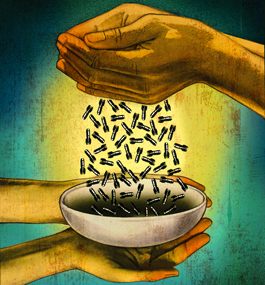Food Wars
Hunger may be the deadliest weapon in conflict areas around the world.

Craig Larotonda
As violent unrest spread throughout the Arab world this year and Libya erupted into civil war, innocent civilians were cut off from food, water and medicine, victims of an age-old strategy deployed in war or in conflict from ancient Chinese to Biblical times, from the U.S. Civil War to today.
Anthropologist Ellen Messer, a visiting scholar in the Heller School’s Institute for Global Health and Development and an adjunct associate professor, has spent her career researching world hunger and the human right to food, especially in conflict zones. She studies food systems and food chains and the policies that influence them. Messer has spent decades researching the complex roles that food insecurity — inadequate access to nutritional, safe and sufficient food — and hunger play in conflicts in the developing world.
A self-described scholar-activist, Messer came of age professionally in the 1970s, when Frances Moore Lappé’s “Diet for a Small Planet” and “Food First” books began to revolutionize thinking about food sustainability and the human right to food. Her research has helped convince the United Nations and NGOs to make food programs and projects more sensitive to conflict and social divisions, whether those fractures are caused by politics, geography, religion or ethnicity.
Messer teaches, lectures widely and organizes workshops on topics of sustainable food systems and food justice for academic, government and civic audiences. She is also a culinary historian and contributor to “The Cambridge World History of Food,” a massive two-volume reference work that summarizes food and nutrition throughout the span of human life on earth.
Here Messer discusses her research over almost three decades of scholarship with Brandeis Magazine editor Laura Gardner.
When did you coin the term “food wars” and what does it mean?
My colleagues and I developed the term in the mid-1980s to capture the close connection between hunger as a weapon of war and hunger as an effect of war in the developing world. Hunger and war are synergistic. Historically, particularly in Africa, but also in Asia, U.S. food aid emphasized relief efforts and agricultural investment to combat hunger. We paid very little attention to the way conflict was a factor in food underproduction and to how the legacy of conflict reduced livelihoods, health systems and community infrastructure. The term “food wars” brings all these factors together.
How does conflict lead to food insecurity and hunger?
 |
|
Ellen Messer |
In armed conflict, food is deliberately used as a weapon. Conflict causes a tragic cascade of events. Adversaries starve communities by seizing their food stocks, appropriating their pastureland, mining their fields, poisoning their water and cutting down trees. Food production gets wiped out; food and trading markets are destroyed. If herders and farmers have less livestock to trade and it’s more difficult to get to market, or there is no market, access to food and livelihoods are sharply reduced. Soon malnutrition becomes rampant because there is less food overall, and people have much less income to buy food. Health services are typically destroyed, too. People are forced to flee, and it becomes extremely difficult for them to return. The legacy of conflict becomes widespread and hunger persists at the national, community, household and individual levels.
For example, food insecurity and malnutrition are widespread right now in Ivory Coast, even though it is a wealthy country and is the world’s largest cocoa grower. During the disputed presidential election early this year, you could see how outgoing president Laurent Gbagbo planned to use income from cocoa as a weapon to fund his continuing military maneuvers. He seized control of all cocoa exports with this in mind. The opposition, in response, blocked cocoa exports until the political situation had been resolved and Gbagbo had been removed from power.
Between 1970 and 1990, violent conflicts led to hunger and reduced food production and economic growth in more than 40 developing countries. Two decades later, what has changed?
We’re still observing the hunger legacy of past conflicts and new cycles of hunger and conflict. Even where peace treaties have been signed, many of these countries are still in need of emergency food aid because infrastructure has been destroyed and corruption at many levels prevents governments from functioning. Today’s food wars are taking place in areas like Sudan’s Darfur region and in the Greater Horn of Africa, which encompasses Ethiopia, Eritrea, Somalia and the Democratic Republic of Congo. There are also disruptions to food production, food markets and health services tied to the ongoing conflicts in Iraq and Afghanistan.
What does the global picture of food insecurity and hunger look like?
We live in a world that has more than enough food to feed everyone on the planet a nutritionally adequate, basic diet, and that has been the case since the 1970s. The problem is who controls food and the global food system. In 2007 and 2008, there was a food crisis caused by spot food shortages and food-price spikes in various countries around the world. In some cases, food was diverted for use as biofuel or as livestock feed; in other cases, it was hoarded. As a result, according to estimates by the U.N. Food and Agriculture Organization, an additional 100 million people experienced extreme food poverty: They could not afford to access a nutritionally adequate diet. Prices moderated but are climbing again and are still quite volatile. At any given time, about 1 billion people lack access to nutritionally adequate food on a regular basis. Even in the United States, up to 15 percent of the population suffers from food insecurity. That means that there are days when poor people, because they lack money for food, don’t know where their next meal will come from.
page 2 of 2
Siege and starve — is that the typical strategy of adversaries in conflict?
It’s a typical strategy that dates back to biblical times and the ancient Chinese. Today, the international community tries to limit deaths from starvation by moving food into zones of armed conflict. The Geneva Conventions prohibit intentional starvation of non-combatants, and a dedicated and vigilant international humanitarian community takes lifesaving action, which is supposed to be apolitical. For example, in 1992, in southern Sudan, rebels tried to prevent food from reaching government supporters in urban areas, while government forces tried to isolate and starve out rebel groups. Through the United Nations, the international community airlifted and arranged convoys of food into this war zone, saving lives. Even where the United Nations imposes economic sanctions to try to oust undemocratic regimes, essential food is allowed in.
You have written that some individuals always profit in times of shortage and conflict. How?
Some people hoard food and sell it at outrageous profit. Then there are those who sell and bear arms — they have the means to commandeer food. In zones of armed conflict, food convoys need armed protection, so the agency bringing in the food enters into contracts with some of these armed groups, effectively giving them control over the food in the process. Food convoys try to contract with the good guys, but it is often really hard in these situations of violent conflict to figure out who the good guys are, or to keep those with arms from stealing or diverting most of the food.
Are women, children and the elderly always the biggest victims in food wars?
Women, children and the elderly are usually the ones without the means to commandeer guns and without the wherewithal to protect the food. They’re left behind. It’s about guns, but it’s also about mobility. We do see more examples of women being involved in armed movements — for example, in Liberia, Sierra Leone and northern Uganda. But for those left behind in a devastated village, it’s difficult to grow, access or save food. Livestock and food stocks are likely to be looted. In post-conflict areas where the land is heavily mined, people are naturally fearful of farming, and they may also lack the seeds and tools to farm. They’re just less likely to be able to make it on their own without outside assistance.
The United States is the world’s largest donor of humanitarian food aid. What could we be doing better?
We provide access to food sourced mainly from U.S. farmers and transported on U.S. ships and planes. In many situations, a more efficient and acceptable plan would be to make food purchases closer to the area in need. This would avoid the delays and the sometimes inappropriateness of the kind of food we offer. For example, we send U.S.-grown yellow dent “cow” corn to countries in southern Africa instead of the white flinty corn that people actually use in their porridge.
What can Americans do to help minimize the exploitation of food as a weapon in conflict zones?
Buy coffee from fair-trade organic cooperatives. Make your consumer preferences about fair-trade products known to the companies whose products you use. Get involved in your community or faithbased organization to make sure that people are talking about these social justice issues. Consumers shouldn’t lose sight of the role that everyone plays in developing more just working conditions around the world. Look at Walmart’s increased sales of fair-trade and sustainable coffees, and organic dairy and cereal products, and you’ll see that the giant retailer is certainly responding to consumer concerns about food safety, sustainability and fairness. Ordinary citizens can stay politically active and informed and pay attention to where their food is coming from.
